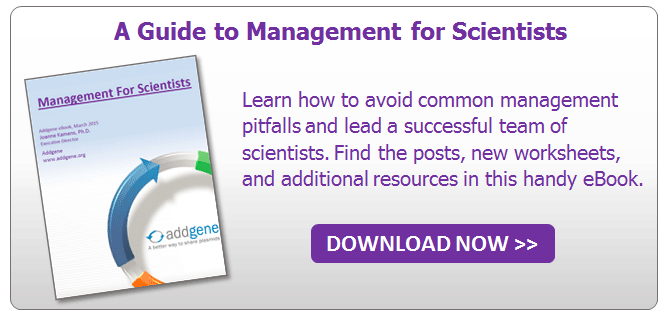This post was contributed by Damien Wilpitz founder and lead consutant at Experiment Designs Consulting, Inc.
 “How much do you need [for your lab start up]?” A hiring chair or dean will often ask a faculty candidate. Sweaty palms. Heart racing. Cotton mouth.The candidate may find it difficult to answer and these are all symptoms of a negotiation, especially when money is involved. However, it doesn’t have to be this way, if you know what you need.
“How much do you need [for your lab start up]?” A hiring chair or dean will often ask a faculty candidate. Sweaty palms. Heart racing. Cotton mouth.The candidate may find it difficult to answer and these are all symptoms of a negotiation, especially when money is involved. However, it doesn’t have to be this way, if you know what you need.
Most often, early career scientists aren’t trained to have these types of negotiations. They usually turn into “win-lose” negotiations. This leads to poor outcomes; not enough funds to get started, wasting funds on unnecessary materials, or even a loss of the offer all together. The problem is that the discussions usually focus on the numbers, rather than the necessary resources. This is why at Experimental Designs Consulting (EDC), we instead have our clients focus on their experimental needs and consider a budget as a resource checklist.
A budget is an account of the material resources needed to accomplish your science, and can include: equipment, reagents, animals, glassware, and even people. When developing a budget, I suggest that you focus on defining these resources and not on the financial aspects. Money often carries an emotional weight. Therefore, too much focus on money can dissuade a productive negotiation. A more productive discussion first defines the material resources needed, then determines how much those resources will cost and how these costs can be reduced. Negotiating is easier when both parties are clear on the goals and the resources.
Instead of creating a start up budget, create a start up list.
In this post we’ll help you successfully negotiate a start up award by giving you step by step instructions on creating a budget, making decisions based on that budget, and negotiating in regards to the budget.
Creating a budget
We start by using your research specific aims. This is actually why a department/institute is interested in you. Your science will define your success. Therefore, it only makes sense to reverse engineer your budgetary needs from your experimental goals.
When creating your budget, you should take the following steps:
1. Define your timeline
Start with your thesis in mind. Imagine the kind of data your dream discovery will need, and how long it will take to publish based on these findings. Most often we suggest estimating the time it will take to secure your first (R-level) research grant. Set your timeline from there, then start identifying the resources needed to accomplish that goal.
2. Identify the tools in that timeline
Avoid writing down prices as you create your list. This helps to ensure that all of the resources are accounted for. Write down all of the major equipment that you use in your current lab first. Generally, major equipment can be defined as equipment with capital costs greater than $5,000 but this can depend on the institution/funding source. Major equipment includes large centrifuges, sequencers and analyzers, and any ultra sensitive equipment (RT-PCR, Microscopy, Fluorescence Scopes, Flowcytometers, etc.).
After identifying all the major equipment, categorize all of your minor tools, like pipets, or mini-centrifuges, etc. Be sure to capture as many of these tools as possible, this even includes clocks, timers, and phones.
As for reagents and consumables (such as pipet tips, glassware, etc), get a simple list from your current P.I., lab manager, or administrator containing all of the materials that you’ve used within the past year to get an idea of how much you can expect to use in the future.
3. Identify the skills needed to use these tools
Outline the knowledge and skill sets needed to do your science. This will help you identify the talent pool that you’ll need to tap for your future research team. For example, if you’re going to need a tech because you’ll be doing mouse experiments, start defining keywords you’ll want to find in candidates’ resumes or CVs; “vivarium”, “weaning”, “colony”, etc. This will help save time by screening out irrelevant candidates, and, more importantly, it’ll help you define salary costs.
4. Ascribe a cost structure associated to these tools, skills, and personnel
Define pricing according to all of the needed materials, and resources that you’ve thoroughly identified. Do online searches, and seek advice from your current administrative services, managers, and techs’ financial books.
To find personnel salary ranges, go to online job information sites (like, indeed.com, or salary.com). Search industry and academic job titles in the regions where the host institute is located. For example, salaries in Kansas versus salaries in NYC will vary widely. Therefore, start up awards should reflect salaries in the region you’ll be working.
At this point, your budget bottom line costs may be rather high. That’s normal, because this is where you can start to identify which items aren’t critical to your research success. If you can get away with using computer modeling and collaborations rather than using animals, then that’s a cost that you can eliminate from your budget. Every cut you make signifies that you've made a conscious effort to eliminate some of the excessive costs in your lab. That in itself is a strong negotiating tactic, and puts you ahead of most start-up P.I.’s.
It doesn’t have to be complicated, or difficult to create this list. Start BEFORE searching for a faculty position. This is important to ensure that you’re looking at institutes that have the means to support your work. For example, if your work requires specialized equipment, try finding institutes that offer shared equipment that you can use at a lower cost. Don't tether yourself to a lab that doesn't have what you know you need.
Prioritizing resources in your budget
The simple practice of putting together a resource budget will help you focus on your research goals and hopefully remove some of the anxiety that comes with negotiations. This creates a self-assured discussion when it comes time to decide what resources to keep, and which ones to abandon. It’s critical to make these decisions in the following order of importance:
1. First make decisions based on experimental timelines and specific aims.
2. Then make decisions based on financial values.
All too often, we see early investigators making unnecessary short term sacrifices that hurt their goals, rather than focusing on long term investments. For example, purchasing “used” equipment can save you money in the short term. However, the financial risks associated with old equipment, like service repairs, labour costs, and loss of time, can exceed the cost of the new equipment. That’s why a resource budget can help you compare the monetary and empirical value that helps you determine whether or not to proceed with a used or new item. To further illustrate this point, if your research is dependent on a pathology microtome/cryostat, then making a careful decision on the condition and availability of the equipment is of utmost importance.
Conducting a successful lab start up negotiation
Now that you’ve completed a resource budget, and know how to decide which components are the most critical to your research, negotiations can be much easier. However, negotiations can still go horribly awry when several factors aren’t taken into consideration.
1. Always focus on the science
When negotiating finances, instead of solely discussing numerical values, try to keep conversations focused on research relevant objectives and their tangible resources. For example, if a dean/chair asks “how much do you need to start your lab”. You can respond by saying, “The exact start up costs may vary greatly. However, I have a list of what I really need in order to reach my research goals. Would I be able to get access to these materials?”
2. Always negotiate for a win-win decision
An institute/department is investing in you, and is counting on your research success. Your success is their success. Therefore, assume positive intent. Sometimes, “no we don’t have the funds,” really means they don’t have the money. If the department has a strict budget, or a lack of resources, then ask for suggestions to meet each others’ needs and limitations. Everything is negotiable. Try asking for discounts, collaborations, access to internal award applications, etc. If this is the institute that can help you and your research, then it’s worth working within their limitations.
3. Always provide value to others
This is a non-profit organization. Therefore, collaboration and community is the ultimate value proposition. By preparing a budget before hand, you’re saving the institute time and energy that would typically be wasted going through some of the questions we mentioned previously. There is value in the process of creating a budget; you can share your budget with fellow researchers and save them time in the future. Showing that you are willing to work and share with others will help prove that you will be an asset.
4. Always ask, “Is there an alternative?”
As scientists, working with this question is second nature. Channel your inner curiosity and use your research training to help you find other solutions to reach your goals. For example, a junior investigator turned down a faculty position because none of the offering institutes were able to provide the resources required for him to meet his goals. Therefore, he turned from academia altogether and instead started a company around his own research. He was clear on his science, and found a solution. However extreme a solution may seem, you should consider it if it will help you achieve your research goals, even if that means saying no to a negotiation or, in this case, to academia altogether.
The primary point of a negotiation is to create a win-win solution for the success of your science. If the resources aren’t available, then you’re entering a win-lose situation that can ultimately set you up for failure.
Don’t be afraid to walk away from a negotiation. If securing a faculty position is your goal, then a resource budget negotiation is a moot discussion. However, if being a successful independent scientist is your goal, then understanding your needs is critical to a successful negotiation and collaboration.
We’d love to hear more about your experiences and opinions on creating and negotiating budgets and invite you to leave a comment below
Happy Sciencing,
Damien

Damien Wilpitz is a laboratory research management consultant and coach in Boston, MA. He specializes in assisting research scientists create productive and manageable laboratory environments. His business skills enhance his passion for science. Follow him on Twitter @XpDesignsMGNT
Additional Resources
- Find other career posts on the Addgene Blog!
- Learn more about Experimental Designs Consulting at their website.
Topics: Science Careers, Applying for Jobs, Early Career Researcher







Leave a Comment